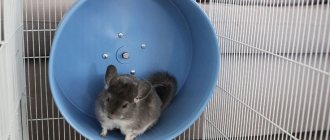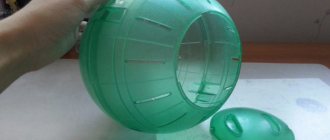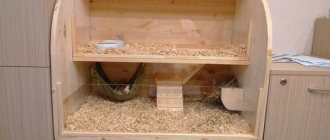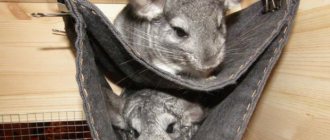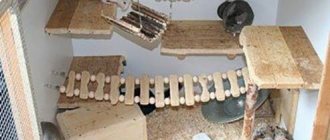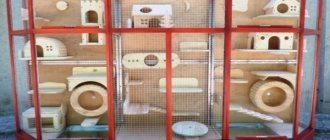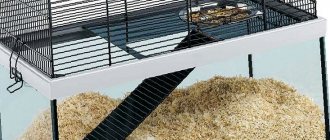- home
- Chinchilla
03/28/2019 When choosing a chinchilla as a pet, you need to be prepared for the fact that the animal is active. He will not be cheerful and healthy if he is not provided with room to move. Does a walking ball solve this problem? Is it worth resorting to this method of organizing a promenade for chinchillas? The answers to these questions are in this article.
Sphere for a rodent - what is it?
In the wild, chinchillas move a lot, as these animals live in mountainous areas. Tamed pets are forced to stay locked up. Natural data and genetic predisposition require active movement in order to maintain the health of the animal. For this purpose, an invention such as a walking ball for a chinchilla was invented.
The product consists of two interconnected hemispheres and is made of durable translucent plastic. Additionally, there are holes for ventilation and an entrance hatch. The animal is placed inside the device and closed. He will not be able to get out without human help unless the attraction for some reason collapses. The diameter of the ball can be from 18 to 32 cm.
The main argument for using this method of walking is that the chinchilla will not be able to chew the furniture or climb into a hard-to-reach place in the apartment.
Manufacturers of the product claim that a rodent can run several kilometers a day in such a device to compensate for the required physical activity.
Rat drinking bowl
A tailed pet should always have access to clean, fresh water, so a water bowl for a rat is one of the most important and necessary accessories when equipping a cage. Different materials are used to make drinking bowls: plastic, glass, earthenware or ceramics. These items also differ in structure, design and volume, and which one to choose depends on the personal preferences of the owner.
Ceramic or glass bowls
Beautiful to look at, but impractical. The water in such drinking bowls must be changed several times a day, since food debris, filler granules or rodent feces may get into the drink, as a result of which the liquid becomes an excellent environment for the development of bacteria. In addition, while roaming, rodents often turn over bowls of water, and the owner has to do unscheduled cleaning of the cage to replace wet bedding. Such drinking bowls can be used for milk or kefir, removing them immediately after the animal drinks.
Nipple drinker
Very convenient, it is a plastic or glass container with a spout located at the bottom into which water is supplied. This accessory is installed on the outside of the cage so that the spout fits between the sections and the animal can drink clean water whenever it wants.
Ball drinkers
No less popular among rodent owners are ball drinkers for rats, the operating principle of which is based on the same principle as nipple drinkers. The only difference between these items is that in place of the spout of a ball drinker there is a metal tube with a movable ball inside. Water trickles out of the tube as the animal moves the ball with its tongue.
Important: the water in the drinking bowl should be changed at least two to three times a week, and the containers themselves should be washed once every seven days with warm water, without using household chemicals.
To learn how to make a drinking bowl with your own hands, we recommend reading the article “How to make a drinking bowl for a hamster.”
Why is a walking ball dangerous?
A walking ball has many disadvantages:
- In natural conditions, chinchillas do not move by moving their paws, like cats, but by jumping. This is impossible in a ball.
- The curved design of the product suggests a flexible spine and a plastic constitution. The chinchilla's skeletal system is rigid and fragile.
- Rodents react very hard to lack of fresh air and overheating. Ventilation holes do not completely solve the problem. The animal may lose consciousness.
- The plastic from which the ball is made can release toxins when heated, which is very dangerous for the rodent.
- In reality, the animal does not happily run around the apartment inside the sphere, but convulsively and panickedly tries to get out of it, receiving psychological stress.
As a result, it turns out that the ball solves the problem for the owner, and the animal suffers.
Rat carrier
Sometimes there is a need to transport a pet, for example, you need to take the animal to the veterinarian, visit an exhibition with it, or simply take it with you to the dacha. For such cases, it is advisable to purchase a special carrier to make the animal’s trip as comfortable and convenient as possible.
Rat carriers are a container made of opaque plastic with a hinged lid. There are longitudinal ventilation holes on the sides of the container or on the lid to supply oxygen. Some carriers are equipped with a feeder so that the rodent can have a snack on the go.
When choosing a rat carrier, you should remember:
- this accessory should be roomy and spacious, especially if it is planned to transport several pets at once;
- It is advisable to give preference to a carrier with side slots for ventilation, since air circulates better in them and you won’t have to worry about the rat suffocating;
- the container must be made of durable and hard plastic so that the animal cannot gnaw a hole in it and escape;
- transportation for a rat is always stressful and the animal begins to defecate frequently out of fear, so the bottom of the carrier should not be covered with cloth or paper so that the pet does not sit on a damp bedding;
- when transporting a rodent in the cold season, the carrier must be placed in a fabric bag, since rats can easily catch a cold;
Important: you cannot use a cardboard box to transport the animal. In such a homemade carrier, the animal can not only gnaw a hole, but also suffocate from lack of oxygen.
What is a walking ball for?
Questions that can be solved by using a walking ball:
- You can quickly and easily place an animal in this product and close it;
- the pet will not climb under the sofa or closet during a walk;
- wires and furniture will be inaccessible to his teeth;
- the animal will be able to move actively without fear of being stepped on.
These can only be realized when the product is made of high-quality plastic and has a good fastening system.
Saving and saving your refrigerator
Summer, as everyone has noticed, has become very hot. From 30 degrees and above. I noticed how long the refrigerator runs. And it wastes a lot of energy. I did this by blowing the radiator. The idea came from memory from the magazine “Young Technician”.
The motors operate under the control of such a temperature relay. It allows you to set the boundaries of the relay operation. I chose the relay based on economy.
This is how I mounted the measuring sensor.
Power supply from such a 12 volt unit.
Even according to the most moderate estimates, such a device reduces the operating time of the compressor by 15 percent. Accordingly, there is less wear on the compressor and energy costs.
True, you need free space to place the fan.
There are relays with a ready-made housing.
When installing the relay, it can be configured (for perfectionists): one point is taken in water with ice (0 degrees), the second in a boiling kettle (100 degrees).
Fans: 120 mm in diameter, 2 pieces or more. Less - there will be no air flow.
Based on selection, I chose 36 degrees as the switching point.
There are such devices on 2 refrigerators.
In summer, when the temperature is 30 degrees and above, the refrigerator does not work around the clock.
Accessory selection
Choose a walking ball based on the size of the animal. When very small, his back will arch. This is not only uncomfortable, but also extremely traumatic. In a large structure, the animal will “dangle” from side to side and will quickly get tired.
As for the ventilation holes. To ensure good air exchange they must be large. However, there is a danger that while running the foot will get stuck with all the ensuing consequences. Therefore, manufacturers are looking for a compromise solution.
Various models are available for sale. There are spheres with the help of which the animal has the ability to move in different directions. In designs with a track, the trajectory of movement is already specified.
In a transparent product, the animal has better visibility.
What kind of rodents run in a wheel?
Runners for rodents are used if the animal is kept in a cage that does not allow it to move a lot and quickly. Lack of activity causes obesity, muscle weakness, chronic diseases, and shortens life expectancy.
Wheels and balls for rodents allow you to reproduce natural habitat conditions. The animal instinctively understands what the device is intended for and how it is used. Often, it is enough for the owner to help the pet once.
They are used when keeping fast-moving animals - rats, hamsters, mice, and less often chinchillas. The rabbit wheel is not used - this animal does not run, but jumps.
How to use such a toy?
If you decide to use a ball for a chinchilla, you need to accustom it to it gradually. It is not recommended to leave it inside for more than 3-5 minutes at first. “Training” should bring satisfaction to your pet, not fear.
If your chinchilla panics when he sees the ball, there is no need to insist. Nothing good will come of this idea. There are exceptions when the pet is interested in this idea and asks to stretch its paws.
Sometimes, to achieve mutual understanding, you need to put a treat in the sphere. When the animal eats it, you need to slowly start rotating the device. This way the pet will quickly understand what is required of him.
Children need to be explained that they cannot leave the animal in the ball for a long time. If they initiated such a walk, you need to monitor the process and make sure that the pet is removed from this attraction on time.
MIFARE copier for 220 rubles
We continue the series of posts about rfid tags and how to record them.
The post Copying the key from the MIIFARE intercom with an MCT phone aroused considerable interest among readers. A method was described for copying keys using an Android phone to CUID MCT blanks. The next post was a continuation. Continuation of the post “Copying the key to the MIIFARE intercom with an MCT phone” Copying blanks using pn532 and a phone with OTG to ZERO blanks. This one will be about the simplest assembly of the cheapest copier MIFARE 1k.
There are many devices for reading and writing mifare. The first thing that comes to mind is proxmark3. This is a really cool thing, a multitool in the world of RFID tags.
No less popular is the ARC122 reader.
But the inner Jew does not want to overpay. Therefore, we choose a copier for pn532. Or rather, the board is a module for projects on Arduino and other microcontrollers. It has HSU or UART mode. We will work with him. A module like this will do.
To connect it to a phone or computer, we need a USB-UART adapter. Anyone, for example.
Connection couldn't be easier. On the board we need 4 pins, VCC, GND, RX, TX. They are signed. Connect to the corresponding ones on the adapter. Only RX and TX are mirrored. RX-TX, TX-RX. That's it, our copier is ready. To fully work with a computer, ideally you need to install something on Linux, for example kali. But we are lazy assholes, and setting up a copier with Windows is a hemorrhoid, and working in a terminal can be intimidating. Therefore, catch the archive with a convenient program. https://cloud.mail.ru/public/mdnR/BrMf2jJGv
I use a copier with a computer, we can read unencrypted tags, encrypted ones knowing the keys (post about the sniffer here Mifare 1k copier / sniffer), and also write CUID MCT blanks. You can also write ZERO, but unfortunately, you won’t be able to change the UID using this software.
DIY walking ball for chinchilla
The price of such a product is usually not low, from 500 rubles and above, depending on the modification, quality, and brand. Folk craftsmen learned to make it from improvised materials.
Necessary materials
The material can be an ordinary plastic bottle. The main requirement is that it must be transparent and fit in size. Ideally, it is a rounded or oval shaped bottle.
Manufacturing process
The bottle is screwed on with a cap. Using a hot rod, holes are cut in the walls. Remove burrs with sandpaper. There is an entrance hatch at the bottom. To do this, the bottom must not be cut all the way around. Instead of a latch, you can use a small piece of tape or tape.
You need to use a homemade device carefully. A chinchilla is not a toy, but a living creature. You can only establish contact with a pet when you treat it with care and love.
Running wheel designs
Manufacturers offer many types of running wheels, differing in design, mounting method, and material. Let's talk about the main varieties.
Stairs
Their running surface consists of crossbars. It is convenient for the rodent to push off, grabbing the crossbar not only with its claws, but also with its fingers. Disadvantage: the foot may fall into the gap, which can lead to injury. Careful selection of wheel size allows you to avoid injury.
For babies and dwarf breeds of hamsters, a diameter of 9-16 cm is recommended - models Darell, Inter Zoo, Triol, IPTS. The distance between the crossbars is carefully calculated - the likelihood of injury is minimized.
The Green Farm model hamster wheel on a stand is made of wood - a safer option and an excellent design solution. Suitable for adult dzhungarik, white mice, cubs of dwarf breeds - diameter 16 cm.
Mesh
Its surface is made of metal mesh. Injuries are completely eliminated. The Inter Zoo running wheel offers two installation options – on a stand or fixed to the cage wall. The Darell brand line includes diameters up to 35 cm - a large rodent wheel suitable for chinchillas and rats.
Solid plastic
Solid surface with relief for ease of repulsion. Models Triol WL05 and silent hamster wheel IPTS are equipped with sides that prevent the pet from falling out when running. The Triol Sputnik wheel has a parabolic shape - it is safe and designed for the smallest animals.
When choosing a model, pay attention to the installation method:
- Stand – installed on the floor, suitable for spacious cages.
- Wall mount – fixed on the cage lattice, allowing you to maintain space for the animal to move. If the kit does not include a fastening device, you can use improvised means - strong wire, cord.
For owners who have not decided on the choice of installation method, we recommend a universal model - Inter Zoo metal hamster stair wheels, the stand of which is equipped with hooks for hanging. The hamster wheel on the stand must be stable - we recommend additionally securing the device to the wall with a rope.


